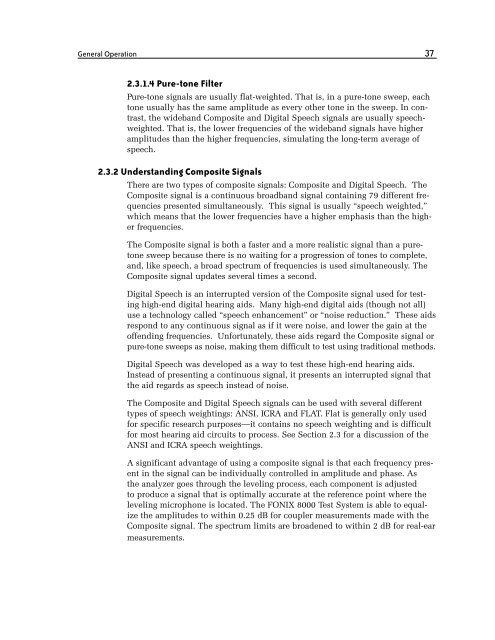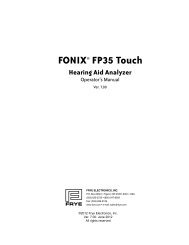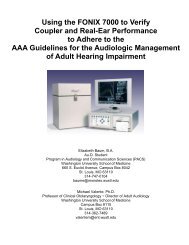FONIX® 8000 - Frye Electronics
FONIX® 8000 - Frye Electronics
FONIX® 8000 - Frye Electronics
You also want an ePaper? Increase the reach of your titles
YUMPU automatically turns print PDFs into web optimized ePapers that Google loves.
General Operation 37<br />
2.3.1.4 Pure-tone Filter<br />
Pure-tone signals are usually flat-weighted. That is, in a pure-tone sweep, each<br />
tone usually has the same amplitude as every other tone in the sweep. In contrast,<br />
the wideband Composite and Digital Speech signals are usually speechweighted.<br />
That is, the lower frequencies of the wideband signals have higher<br />
amplitudes than the higher frequencies, simulating the long-term average of<br />
speech.<br />
2.3.2 Understanding Composite Signals<br />
There are two types of composite signals: Composite and Digital Speech. The<br />
Composite signal is a continuous broadband signal containing 79 different frequencies<br />
presented simultaneously. This signal is usually “speech weighted,”<br />
which means that the lower frequencies have a higher emphasis than the higher<br />
frequencies.<br />
The Composite signal is both a faster and a more realistic signal than a puretone<br />
sweep because there is no waiting for a progression of tones to complete,<br />
and, like speech, a broad spectrum of frequencies is used simultaneously. The<br />
Composite signal updates several times a second.<br />
Digital Speech is an interrupted version of the Composite signal used for testing<br />
high-end digital hearing aids. Many high-end digital aids (though not all)<br />
use a technology called “speech enhancement” or “noise reduction.” These aids<br />
respond to any continuous signal as if it were noise, and lower the gain at the<br />
offending frequencies. Unfortunately, these aids regard the Composite signal or<br />
pure-tone sweeps as noise, making them difficult to test using traditional methods.<br />
Digital Speech was developed as a way to test these high-end hearing aids.<br />
Instead of presenting a continuous signal, it presents an interrupted signal that<br />
the aid regards as speech instead of noise.<br />
The Composite and Digital Speech signals can be used with several different<br />
types of speech weightings: ANSI, ICRA and FLAT. Flat is generally only used<br />
for specific research purposes—it contains no speech weighting and is difficult<br />
for most hearing aid circuits to process. See Section 2.3 for a discussion of the<br />
ANSI and ICRA speech weightings.<br />
A significant advantage of using a composite signal is that each frequency present<br />
in the signal can be individually controlled in amplitude and phase. As<br />
the analyzer goes through the leveling process, each component is adjusted<br />
to produce a signal that is optimally accurate at the reference point where the<br />
leveling microphone is located. The FONIX <strong>8000</strong> Test System is able to equalize<br />
the amplitudes to within 0.25 dB for coupler measurements made with the<br />
Composite signal. The spectrum limits are broadened to within 2 dB for real-ear<br />
measurements.
















